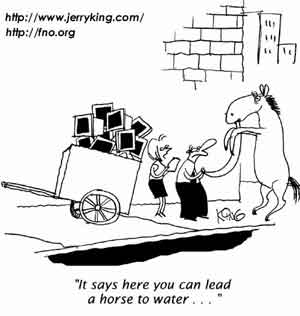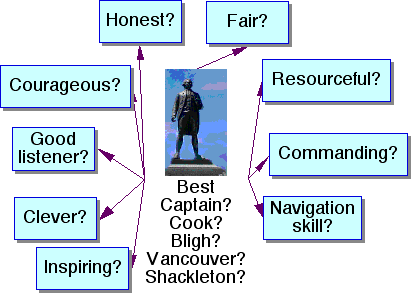|
|
| Vol 12|No 9|May|2003 | |
|
Please feel free to e-mail this article to a friend, a principal, a parent, a colleague, a teacher librarian, a college professor, a poet, a magician, a vendor, an artist, a juggler, a student, a news reporter or anyone you think might enjoy it. Other transmissions and duplications not permitted. (See copyright statement below).
For a decade now, schools and teachers have been pressed to integrate new technologies into daily classroom life. Behind these pressures lurks a Technology Presumption: that new tools will enhance any classroom and any lesson. A corollary is the belief that each student should have his or her own laptop or handheld device. Those who have made concerted efforts to integrate new technologies into daily classroom life can report with some confidence that the Technology Presumption is false and wrong-minded. There are many times when new technologies and digital information fail to enhance a lesson. There are many times when new technologies and digital information fail to meet lesson goals entirely. And there are many times when sharing equipment works best.
Part of why we call these pressures the Technology Presumption is the lack of credible evidence that would support the notion that laptops and new technologies enhance student thinking, writing, problem-solving and performance. To the contrary, they may sometimes dilute, divert and distract.
Instead of starting with clear learning objectives and creating delivery systems to match, many schools went on a shopping spree that coincided with a period of rampant dot-com speculation. In retrospect, both our pensions and our schools would have been better off if we had paid more attention to what investors used to call "the fundamentals." (See May, 2002, FNO article, "Tech Smart: Making Discerning Technology Choices.") Elements in Sound Lesson Design Schools would win bigger returns on investments if they would put the learning goals (the horse) squarely before the cart. The process moves through stages:
Employing a unit development model such as Understanding by Design (Wiggins and McTighe, 2000), teachers orchestrate activities to optimize learning and understanding. Some of these activities might employ new technologies and digital resources, but smart teachers will often opt for other tools and media even when they work in so-called laptop schools or a techno-saturated school. (See September, 2002, FNO article, "The Slam Dunk Digital Lesson.") Discerning Schools and Teachers Discerning schools put first things first. (See FNO September, 2000 article, "First Things First.") Signs of Presumptive Technology Planning When the cart precedes the horse, pressure usually mounts for teachers to use the equipment. Idle equipment is a big embarrassment. Frequent use is the order of the day. Quality use is rarely mentioned.
Different Questions to Ask When program and learning goals are paramount, we hear different questions:
Smart teachers retain lessons, tools and strategies that have withstood the tests of time. They are not prone to jump on every bandwagon that sweeps through schools because they have learned that many of these fashions are short-lived and ineffective. Technology cheerleaders often decry such classically inclined teachers as if they were robbing this generation of students of their educational birthrights, but many skeptical teachers have long established track records or producing good student results. These teachers are not likely to buy the slick packages of proponents who argue that technology is a path to salvation. "Where's the beef?" they rightly ask. "Where's the evidence that these tools and activities will deliver the goods?" Look Before Leaping When the Internet first arrived in schools, we heard various claims about virtual libraries and unlimited digital resources. The reality has fallen far short of these claims, as much of the content available on the Internet is amateurish and unreliable in various ways. A teacher who assumes that the Internet will provide adequate information to support serious investigations is courting disaster. It pays to compare and contrast a variety of information sources as part of the unit planning process so that students are not frustrated by inferior information sources. This step in unit development is called Prospecting. The teacher looks for strong information resources. In addressing the analysis, inference, interpretation, synthesis and evaluation tasks required by state standards, the teacher honors the rule of "No tool before its time." Example One: The Captains A middle school class must research the following question:
Perhaps the teacher has found Inspiration™ a great tool to support the questioning required to explore a demanding issue like this one, so he or she asks students to work as trios with laptops to map out the qualities of a good question along with the subsidiary questions they need to research to compare and contrast the four leaders. At the same time, some members of the class may prefer to map out such questions on huge sprawling sheets of butcher paper that allow them to stretch out on the carpet of the media center and sketch their research plan. A smart teacher leaves room for divergent strategies. An ideologue mandates a digital mind map. What matters here is smart thinking, not the technology employed. Once they have identified key qualities, the students must list the subsidiary questions that will lead them to specific evidence of each man's successes or failures. The list for navigational skill might include the following:
Where are students most likely to find answers to such questions? A teacher might presume that the Internet would be a sufficient source, but a quick look at Google would show the folly of such presumption. An exact phrase search for "Captain Cook" turns up 165,000 Web pages. Many of the first 100 Web pages are related to tourism, gambling or modern cultural offerings playing on the good captain's name. If we add "navigation skill" to the search, the number of Web pages drops to 497 Web pages. Unfortunately many of these pages are provided by amateurs or report the conclusions of others without any specifics. Here's one: (click here for full text)
We have a secondary source but no evidence. Here's another from PlantExplorers.Com: (click here for full text)
Again we have a secondary source but no evidence. As we proceed through the Google listing, we come to a page listing books about Captain Cook. (click here for full text) One of the books listed is The Journals of Captain Cook (Penguin Classics) [ABRIDGED]
If only those journals were available online! Sadly, a Google search for The Journals of Captain Cook turns up only references to printed versions from Penguin Classics and others. (look at Google results) It would be possible to digitize the journals, but as with most of the primary source material needed to compare the ship captains for this research project, digitization has not yet happened. A smart teacher examines the information available from a variety of sources and makes sure students work with that which is reliable and pertinent. Example Two: Understanding Urban America An unsuspecting social studies teacher might look at the photographic archives at the Library of Congress and leap to the conclusion that students could gain an excellent view of tenements by examining the photographs contained in Turn-of-the-Century America ~ Detroit Publishing Company ~ Photographs ~ 1880-1920 But the teacher should look at the 14 photographs that result from a keyword search and determine whether they present a comprehensive, representative, adequate and accurate view of tenements and tenement life. 1 [Exterior of tenement, New York City] Just because a photographer took 14 pictures and labelled them as "tenement" does not mean that this collection is sufficient or reliable. They show buildings in New York City for the most part. A search for "slums" turns up just 2 photos. Large digital archives often seem impressive until one makes use of them as a source to understand a challenging question. The teacher would have to take the time to find a better archive. Would The Picture Collection Online at the New York Public Library give a more thorough view (go to the collection) or would the teacher have to make sure the school library had more powerful photographic collections available in the print collection? After considerable searching I was able to find an amazingly good online source showing the text and photographs from Jacob Riis's book, How the Other Half Lives. These resources were evidently posted as a personal project by a David Phillips in the American Studies Department at Yale.
Judge for yourself whether the size and quality of these online pictures are satisfactory. Would the students would be better off with the print version from Penguin Classics? (see Amazon offerings) or New York Life at the Turn of the Century in Photographs by Joseph Byron? (see Amazon offerings) The main point is the fallacy of presuming that digital resources and new technologies will be sufficient or superior for many educational tasks. Example Three: Hurricane of the Century Sometimes online sources do prove superior. Provided the teacher has taken the time to verify that superiority and build appropriate lesson activities around the source, a digital lesson can work wonders. This process is outlined in some detail in the September, 2002, FNO article, "The Slam Dunk Digital Lesson." A fifth grade teacher may have a great unit on weather but finds that NOAA provides excellent information about hurricanes online. He or she builds the following lesson (go to the lesson). The weather unit may have 2-3 days of lessons rich with digital data and 15 using print materials and community investigations. Each medium and each tool does what it does best. We collect rainwater with cups but measure pH with probes. Conclusion We should not presume that new tools will outperform old tools. This presumption is what Paul Duguid calls "the Myth of Supercession."
Smart teachers will take a look at the tools and the information available to support learning goals and will select in a discerning manner. They will not do new technologies for the sake of technology. Nor will they put the cart before the horse. For additional reading on this challenge, consider the March, 2000 FNO article, "When the Book? When the Net?" http://www.fno.org/mar2000/whenbook.html Toolishness1 is Foolishness! 1 Toolishness (cartoon) It has spread far and wide . . . a fondness for tools that transcends purpose and utility . . . as when folks grab a hammer to paint a flower just because they like hammers or because hammers are trendy or when they allow a computer to speak for them to an audience instead of telling their stories with a natural voice or when people turn to search engines to find truths more likely to reside in books or their own hearts. |
|
Back to May Cover
Credits: The photographs were shot by Jamie McKenzie .
Copyright Policy: Materials published in From Now On may be duplicated in hard copy format if unchanged in format and content for educational, nonprofit school district and university use only and may also be sent from person to person by e-mail. This copyright statement must be included. All other uses, transmissions and duplications are prohibited unless permission is granted expressly. Showing these pages remotely through frames is not permitted.
FNO is applying for formal copyright registration for articles. Unauthorized abridgements are illegal.
|
 From Now On
From Now On




